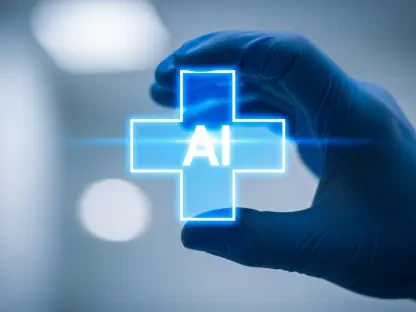The healthcare industry is on the brink of a significant transformation driven by digital advancements. By 2030, the shift from reactive acute care to proactive and personalized care will be well underway, facilitated by technologies such as AI, virtual care, and wearable biosensors. These innovations promise to improve patient outcomes, enhance clinician well-being, reduce costs, and ensure health equity through a data-driven approach focused on population health management.
AI-Powered Healthcare
Enhancing Diagnostics and Treatment Decisions
AI integration in healthcare technologies is set to revolutionize diagnostics and treatment decisions. By analyzing vast amounts of data, AI can identify patterns and predict outcomes with greater accuracy than traditional methods. This capability supports multidisciplinary teams in making informed decisions, ultimately leading to better patient care. For instance, AI algorithms can sift through extensive patient records, radiology images, and genetic data to provide precise diagnostic recommendations, reducing the likelihood of human error. This technological advancement not only accelerates the diagnostic process but also enhances the quality of care.
Moreover, AI’s predictive capabilities extend beyond immediate patient care. By anticipating potential health risks and complications, AI helps in crafting personalized treatment plans tailored to the individual needs of each patient. This proactive approach enables healthcare providers to initiate interventions before conditions worsen, significantly improving long-term health outcomes. The integration of AI in diagnostics and treatment decisions exemplifies how technology can augment human expertise, resulting in a more efficient and effective healthcare system.
Streamlining Administrative Tasks
AI is also poised to streamline administrative tasks within healthcare settings. From scheduling appointments to managing patient records, AI can automate routine processes, freeing up healthcare professionals to focus on direct patient care. This increased efficiency can lead to improved productivity and patient satisfaction. Implementing AI-driven solutions in administrative workflows reduces the time spent on paperwork and administrative burdens, allowing clinicians to devote more time to patient interactions and clinical duties. The automation of these tasks mitigates the risk of errors associated with manual data entry, ensuring greater accuracy in patient records and billing processes.
Another notable advantage of AI in administrative tasks is optimizing resource allocation and capacity planning. By analyzing historical data and real-time information, AI can predict patient influx, manage hospital resources, and allocate staff based on demand patterns. This ensures that healthcare facilities operate efficiently, with minimal downtime and resource wastage. As a result, patients experience reduced wait times, streamlined appointment scheduling, and a more seamless healthcare experience. Integrating AI in administrative functions not only enhances efficiency but also contributes to a higher standard of patient-centered care.
Proactive and Preventative Care
Proactive and preventative care focuses on anticipating health issues before they start and preventing them through regular check-ups, healthy lifestyle choices, and early interventions. This approach emphasizes the importance of maintaining overall well-being and addressing potential problems early, which can lead to better long-term health outcomes and reduced healthcare costs. By staying attentive to one’s health and making informed decisions, individuals can take charge of their well-being and lessen the likelihood of developing chronic conditions.
Early Identification and Timely Interventions
The shift towards proactive and preventative care is supported by technologies that enable the early identification of health issues. Connected care, remote monitoring, and data analytics allow for timely interventions, reducing the need for more intensive treatments later on. This approach emphasizes the importance of preventative care in maintaining overall health. Wearable devices and biosensors continuously monitor vital signs, activity levels, and other health metrics, alerting healthcare providers to potential issues before they escalate. This technology-driven vigilance empowers patients to take an active role in their health management, fostering a proactive approach to wellness.
Furthermore, data analytics plays a pivotal role in predicting health trends and identifying at-risk populations. By analyzing data from various sources, including electronic health records, social determinants of health, and genetic information, healthcare providers can identify patterns and risk factors associated with chronic diseases. This enables targeted interventions and personalized care plans for individuals at risk, ultimately improving population health outcomes. Timely interventions made possible by advanced technologies prevent the progression of diseases and contribute to the overall efficiency and sustainability of healthcare systems.
Emphasizing Preventative Resources
Allocating resources to preventative care is crucial for the future of healthcare. By focusing on early detection and intervention, healthcare systems can reduce the burden of chronic diseases and improve long-term health outcomes. This shift requires a reallocation of funding and a change in mindset toward valuing preventative measures. Investment in preventative care results in significant cost savings for healthcare systems by reducing hospital admissions, emergency room visits, and the need for invasive treatments. Moreover, prioritizing preventative care enhances patient quality of life, as early interventions often lead to better health.
To effectively implement preventative care strategies, healthcare providers must integrate interdisciplinary approaches involving primary care physicians, specialists, and community health workers. Collaborative efforts ensuring patients receive comprehensive support and education empower individuals to adopt healthier lifestyles and make informed health decisions. Initiatives such as vaccination programs, health screenings, and lifestyle modification counseling are integral components of preventative care. By fostering a culture that values proactive health management, healthcare systems can achieve enduring improvements in population health and create a sustainable model for future generations.
Enhanced Efficiency
Smart Hospitals and Digital Command Centers
Smart hospitals and digital command centers are at the forefront of enhancing efficiency in healthcare. These facilities leverage technology to optimize operations, from real-time patient monitoring to automated workflows. The result is improved productivity, better patient outcomes, and higher levels of patient satisfaction. In smart hospitals, technologies such as the Internet of Things (IoT), AI, and robotics work together to enhance patient care and streamline administrative processes. For instance, connected devices continuously monitor patients’ vital signs, sending real-time data to digital command centers where healthcare professionals can promptly respond to any anomalies.
Digital command centers play a crucial role in coordinating patient care and managing hospital operations. These centralized hubs use advanced analytics and real-time data to monitor patient flow, bed availability, and resource utilization. By identifying bottlenecks and optimizing workflow, command centers ensure that hospitals operate efficiently, minimizing delays and improving overall patient experience. The integration of technology in these settings reduces the likelihood of medical errors and enhances patient safety, leading to more positive outcomes and higher levels of patient satisfaction.
Flexible Infrastructure and Automation
The adoption of flexible infrastructure and automation in healthcare settings is essential for meeting the demands of the future. By incorporating IoT, AI, and robotics, healthcare facilities can adapt to changing needs and streamline processes. This flexibility ensures that healthcare systems remain resilient and responsive to patient needs. Automated systems in hospitals can manage various tasks, such as dispensing medications, sterilizing equipment, and transporting supplies, reducing the workload on staff and minimizing the risk of human error. By automating these processes, healthcare facilities can operate more efficiently, allowing healthcare professionals to focus on delivering high-quality patient care.
Flexible infrastructure also enables healthcare facilities to scale operations and services based on patient demand. Modular designs and adaptable spaces ensure that hospitals can quickly respond to changing healthcare needs, such as during pandemics or natural disasters. This adaptability enhances disaster preparedness and ensures that healthcare systems can provide continuous and effective care under various circumstances. The integration of technology and flexible infrastructure in healthcare promises a more efficient, responsive, and patient-centered approach to healthcare delivery, paving the way for a better future.
Democratized Health Data
Secure Availability of Healthcare Data
The secure availability of healthcare data to all care providers is a cornerstone of future healthcare systems. Digitization and secure data sharing enable seamless communication between providers, leading to more coordinated and effective care. This democratization of data is essential for delivering personalized and precise healthcare. Secure data exchange ensures that healthcare providers have access to accurate and up-to-date patient information, enabling them to make informed decisions and provide the best possible care. Standardizing data formats and interoperability between different health systems are critical for achieving seamless data exchange and collaboration.
Ensuring the security and privacy of healthcare data is paramount in the era of digital healthcare. Implementing robust cybersecurity measures and compliance with data protection regulations safeguard patient information from breaches and unauthorized access. Advanced encryption techniques and secure data storage solutions protect sensitive health data, fostering trust between patients and healthcare providers. Prioritizing data security and privacy creates a foundation for healthcare innovation and enables the successful implementation of new technologies.
AI-Powered Data Insights
AI-powered data insights play a critical role in transforming healthcare. By analyzing patient data, AI can provide predictive, proactive, personalized, participatory, and precise (5P) healthcare. These insights enable healthcare providers to tailor treatments to individual patients, improving outcomes and reducing costs. For example, AI algorithms can predict disease outbreaks, identify high-risk patients, and recommend preventive measures, allowing healthcare providers to take timely and appropriate actions. This data-driven approach enhances the overall efficiency and effectiveness of healthcare delivery, ultimately leading to better patient experiences.
AI’s ability to analyze vast amounts of data also enables the identification of trends and patterns that may not be apparent through traditional methods. This helps in the early detection of diseases, monitoring of treatment efficacy, and evaluation of healthcare interventions. By leveraging AI-powered data analytics, healthcare providers can continuously improve care quality and make evidence-based decisions. The integration of AI in healthcare data analysis marks a significant advancement towards a more proactive, personalized, and efficient healthcare system.
Overarching Trends and Constraints
Addressing Skills and Talent Gaps
The availability of skills and talent is a significant constraint in adopting digital advances in healthcare. Comprehensive training programs for healthcare professionals are necessary to ensure they are equipped with the technical skills and data fluency required to leverage new technologies effectively. Creating a specialized workforce that understands the nuances of AI, data analytics, and digital health is crucial for the successful integration of these technologies. This involves incorporating digital health education into medical and nursing curricula and providing continuous professional development opportunities.
Addressing the skills gap also requires fostering a culture of innovation and collaboration within healthcare organizations. Encouraging interdisciplinary teams and promoting knowledge-sharing among health professionals enhances the collective expertise in digital healthcare. Partnerships with technology companies, academic institutions, and research organizations can also play a vital role in advancing digital health capabilities. By empowering healthcare professionals with the necessary skills and knowledge, health systems can fully realize the potential of digital technologies in transforming patient care.
Funding Models and Regulatory Approaches
Diverse funding models and supportive regulatory approaches are essential for fostering innovation in healthcare. By prioritizing preventative care and creating ethical AI frameworks, healthcare systems can overcome financial and regulatory barriers to adopting new technologies. Innovative funding mechanisms, such as public-private partnerships, grant programs, and value-based care models, can provide the necessary resources for implementing digital health solutions. These funding models incentivize healthcare providers to adopt technologies to improve patient outcomes and reduce costs.
Regulatory frameworks must evolve to keep pace with the rapid advancements in digital healthcare. Establishing clear guidelines for data privacy, security, and AI ethics ensures that new technologies are implemented responsibly and transparently. Regulatory agencies play a crucial role in evaluating the safety and efficacy of digital health solutions, providing oversight, and fostering public trust. By balancing innovation and regulation, healthcare systems can create an environment that supports the ethical and effective use of digital technologies, ultimately improving patient care.
Evidence in 2024 and Market Growth
Growth of Smart Hospitals
The market for smart hospitals is projected to grow significantly by 2024. These facilities will integrate technologies like IoT, AI, and robotics to enhance patient care and operational efficiency. The adoption of smart hospital technologies is a key indicator of the broader transformation in healthcare. The increasing demand for high-quality, efficient, and patient-centered care drives the growth of smart hospitals. As healthcare systems recognize the value of technology in improving outcomes and reducing costs, investment in smart hospital infrastructure is expected to rise.
Furthermore, smart hospitals represent a shift towards a more data-driven and connected healthcare ecosystem. Integrating IoT devices enables continuous monitoring of patients and assets, providing real-time insights into hospital operations. This connectivity extends to other healthcare facilities, creating a seamless network for patient care and information exchange. As smart hospitals become more prevalent, they will serve as a blueprint for future healthcare systems, showcasing the benefits of technology in delivering superior care.
Expansion of Remote Patient Monitoring
Remote patient monitoring is expected to see substantial growth, driven by its potential to improve patient outcomes and reduce hospital readmissions. This technology alleviates pressure on healthcare systems by enabling continuous monitoring and timely interventions for patients at home. The COVID-19 pandemic has accelerated the adoption of remote monitoring solutions, highlighting their importance in maintaining continuity of care during crises. As a result, healthcare providers increasingly recognize the value of remote monitoring in managing chronic conditions, monitoring post-operative patients, and providing care to vulnerable populations.
The expansion of remote patient monitoring is also supported by advancements in wearable devices, biosensors, and telehealth platforms. These technologies enable the collection of real-time health data, allowing healthcare providers to track patients’ progress and intervene when necessary. Remote monitoring enhances patient engagement, as individuals can actively participate in their health management. This proactive approach reduces hospital admissions and empowers patients to take control of their health, leading to better overall outcomes and a more sustainable healthcare system.
Impact of AI/Gen AI on Healthcare Sustainability
Integrating AI and Gen AI into the healthcare sector has the potential to significantly enhance sustainability by optimizing resource utilization and reducing unnecessary procedures. By leveraging vast amounts of data, these technologies can improve diagnostic accuracy, personalize treatment plans, and predict patient outcomes. Additionally, AI-driven predictive analytics can help in managing and preventing disease outbreaks, ultimately leading to a more resilient healthcare system. Through automation and improved efficiency, AI technologies can also reduce operational costs and minimize the environmental impact associated with healthcare practices, contributing to a more sustainable industry overall.
Automating Routine Tasks
AI and Gen AI are set to transform healthcare sustainability by automating routine tasks. This automation improves patient flow and enables predictive modeling for crisis preparedness. By reducing the administrative burden on healthcare professionals, these technologies allow for a greater focus on direct patient care. Automated systems can manage tasks such as appointment scheduling, billing, and documentation, significantly reducing the time and effort required for administrative processes. This automation enhances efficiency and minimizes the risk of errors and inconsistencies in healthcare operations.
Predictive modeling enabled by AI can anticipate healthcare needs, optimize resource allocation, and support crisis management. By analyzing historical data and identifying trends, AI can provide valuable insights for planning and preparedness in situations such as pandemics or natural disasters. This proactive approach ensures that healthcare systems can respond effectively to emergencies, maintain continuity of care, and minimize disruptions. Integrating AI and generative AI into healthcare sustainability strategies marks a significant step towards creating a resilient and adaptive healthcare system.
Enhancing Staff Support and Patient Interactions
GenAI-powered tools can enhance staff support and personalize patient interactions. These tools simplify healthcare navigation and improve patient engagement, leading to better health outcomes. Gen AI can automate routine correspondence, answer patient queries, and facilitate appointment scheduling, freeing up healthcare staff to focus on more complex and meaningful interactions. Personalized AI assistants can also guide patients through their care journey, providing tailored information, reminders, and support based on individual health needs and preferences.
Moreover, GenAI-powered solutions can enhance clinical decision-making by providing real-time insights and recommendations based on patient data. By integrating AI into clinical workflows, healthcare professionals can access relevant information and evidence-based guidelines, enabling them to make more informed and timely decisions. This reduces the cognitive load on clinicians and improves their ability to deliver high-quality care. The adoption of GenAI in healthcare enhances operational efficiency, promotes patient engagement, and supports healthcare professionals in providing the best possible care.
Global Trends and the Australian Perspective
Shift Towards Community and Home Care
The current model of healthcare delivery, heavily reliant on expensive acute facilities, is unsustainable. There is a global trend towards cost-effective care delivered in the community and at home. This shift requires improved integration of data across health services and consumer-collected sources such as wearable biosensors. This shift aims to enhance patient safety, access to care, and operational processes while leveraging AI-enabled command centers and clinical decision support systems. By transferring the focus of care to patients’ homes and communities, healthcare systems can achieve better health outcomes and reduce the strain on hospital resources.
Home-based care models, such as virtual wards and telehealth services, enable patients to receive comprehensive care without the need for hospitalization. These models utilize digital technologies to monitor patients remotely, provide virtual consultations, and facilitate timely interventions. The success of initiatives like Amplar Health’s virtual My Home Hospital and the Victorian Virtual ED in Australia demonstrates the potential of these care models. By leveraging AI and digital technologies, healthcare providers can ensure the continuity of care while addressing the challenges of an aging population and rising healthcare costs.
Transforming Clinical Training and Procedures
Patients will utilize AI bots for information exchange about their care, reducing the need for workforce-intensive tasks such as scheduling and care planning. For clinicians, AI and ambient listening will support decision-making, streamline clinical note generation and orders, and facilitate better engagement with patients. The use of virtual and augmented reality in clinical training and robotic surgery is expected to enhance care consistency and patient outcomes. These technologies provide immersive and interactive learning experiences for healthcare professionals, allowing them to practice procedures, enhance their skills, and improve patient safety.
Robotic surgery, guided by AI and augmented reality, offers greater precision and control, reducing the risk of complications and improving surgical outcomes. Virtual reality simulations enable clinicians to refine their techniques, familiarize themselves with complex procedures, and collaborate with colleagues in a simulated environment. These advancements in clinical training and procedures ensure that healthcare professionals are well-prepared to deliver high-quality care and adapt to new challenges. The integration of AI and digital technologies in clinical practice promises a more efficient, proactive, and patient-centered healthcare system.
Conclusion
The healthcare industry is poised for a major transformation due to ongoing advancements in digital technology. By 2030, a paradigm shift from reactive acute care to proactive and personalized healthcare will be in effect. This evolution will be driven by innovations such as artificial intelligence, virtual care, and wearable biosensors. These technologies are anticipated to significantly enhance patient outcomes and clinician well-being. By enabling real-time tracking and personalized treatment plans, AI and biosensors can detect potential health issues before they become severe, reducing the reliance on emergency care. Virtual care will make medical advice and treatment more accessible, breaking down geographical barriers and bringing healthcare to underserved populations. Furthermore, a data-driven approach focused on population health management will play a crucial role in reducing healthcare costs and ensuring health equity. Overall, these advancements promise to create a more efficient, equitable, and effective healthcare system by the end of this decade.









